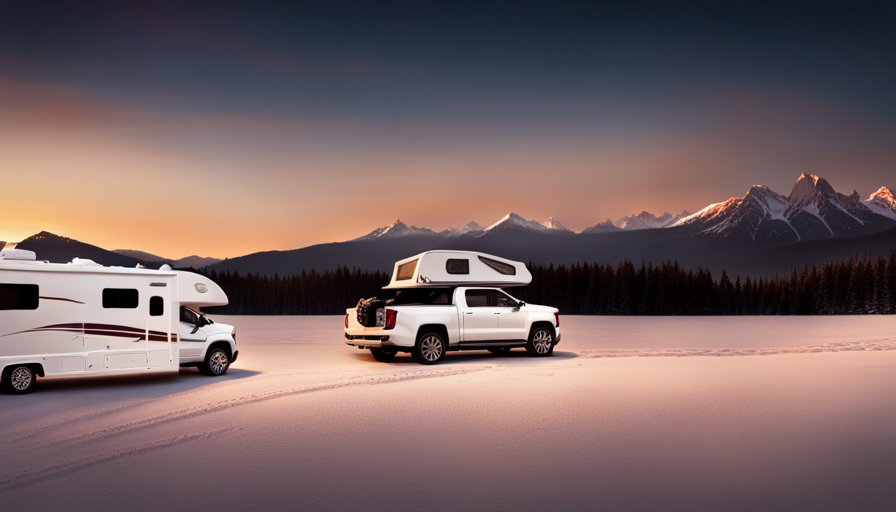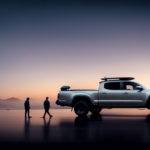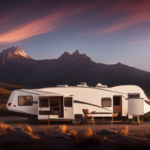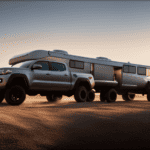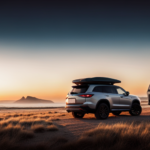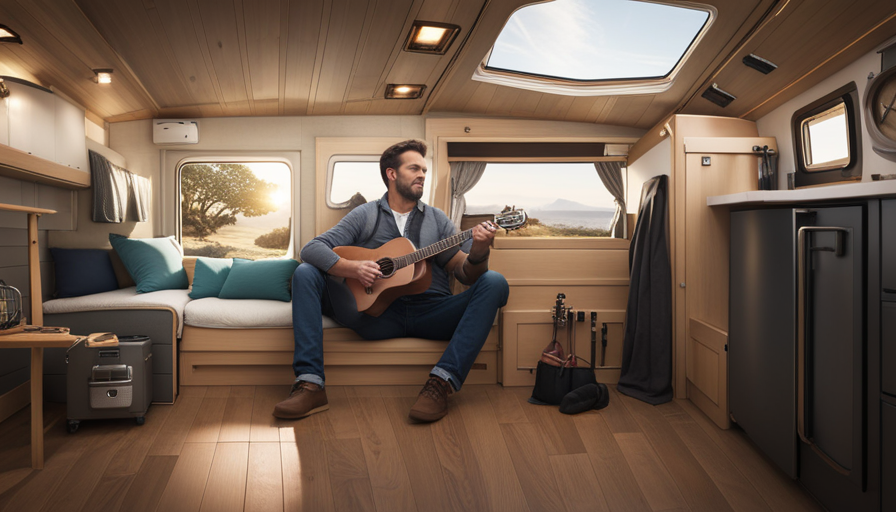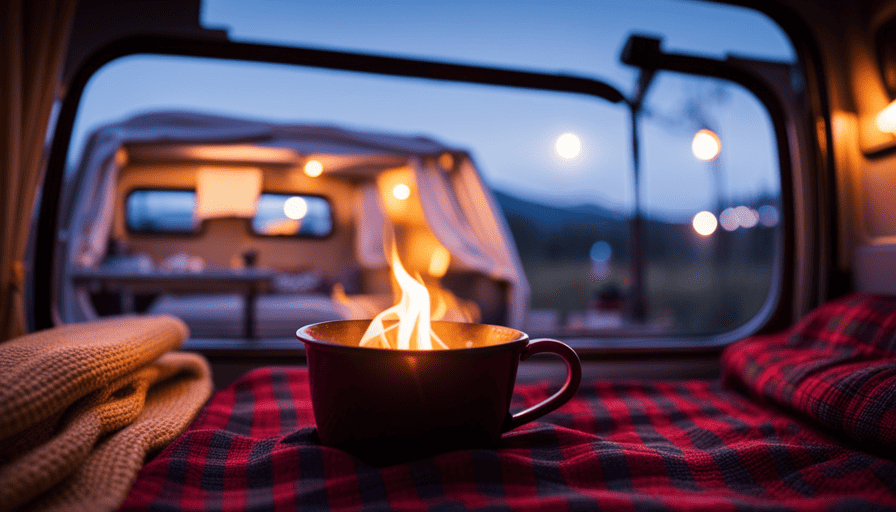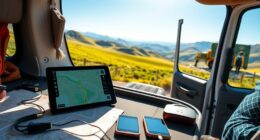Get ready, thrill-seekers! Are you prepared to embark on a journey down the open road, where possibilities are endless and exploration is at your fingertips? Look no further than the powerful Toyota Tacoma, a true king of the roads.
But here’s the burning question on every camper enthusiast’s mind: what size camper can a Toyota Tacoma pull? Fear not, fellow explorers, for we have the answers you seek.
In this informative article, we will delve into the world of towing capacity and payload, uncovering the secrets of the Tacoma’s towing prowess. We’ll explore the factors to consider when choosing the perfect camper size for your Tacoma, from lightweight options for the casual weekend warrior to mid-size and compact options for the more intrepid adventurers among us.
Join us as we dive into the world of camping with your trusty Tacoma, discovering the best destinations and offering tips for safe and efficient towing. So fasten your seatbelts, grab your maps, and get ready to embark on the journey of a lifetime with your Tacoma and camper in tow. The open road awaits!
Key Takeaways
- The Toyota Tacoma has a towing capacity of up to 6,800 pounds and a payload capacity of up to 1,440 pounds.
- When choosing a camper size for the Tacoma, it is important to consider the weight and dimensions of the camper.
- Towing capacity and payload capacity are crucial factors to consider when selecting a camper for the Tacoma.
- Lightweight campers such as pop-up campers and teardrop campers are suitable options for the Tacoma.
Understanding Towing Capacity and Payload of the Toyota Tacoma
If you’re looking to understand the towing capacity and payload of your Toyota Tacoma, you’ll be pleasantly surprised by the impressive capabilities that this powerful truck has to offer.
The Tacoma is known for its ruggedness and reliability, making it an ideal choice for towing and hauling. When it comes to towing, the Tacoma has a maximum towing capacity of up to 6,800 pounds, depending on the specific model and configuration. This means that you can confidently tow a variety of trailers, including small campers and boats.
In addition to its towing capacity, the Tacoma also has a respectable payload capacity. The payload capacity refers to the maximum weight that the truck can carry in its bed. The Tacoma can handle a payload of up to 1,440 pounds, allowing you to load up the bed with gear, supplies, and equipment for your camping adventures.
There are several factors to consider when choosing a camper size for your Tacoma. One of the main factors is the weight of the camper itself. It’s important to ensure that the weight of the camper, including all its contents, does not exceed the Tacoma’s towing capacity. Additionally, you should also consider the size and dimensions of the camper to ensure that it fits properly on your truck.
By considering these factors, you can choose a camper size that is suitable for your Tacoma’s towing capabilities and enjoy the benefits of towing with this reliable and powerful truck.
Factors to Consider When Choosing a Camper Size for Your Tacoma
When selecting the ideal camper for your Tacoma, it’s important to take into account various factors that will contribute to a seamless and enjoyable towing experience. Understanding camper weight restrictions and determining the towing capacity of your Tacoma are crucial steps in making the right choice.
Here are three key factors to consider:
-
Towing Capacity: Start by checking your Tacoma’s owner’s manual or contacting the manufacturer to determine its towing capacity. This will give you a clear idea of the maximum weight your vehicle can safely tow.
-
Payload Capacity: In addition to towing capacity, you need to consider the payload capacity of your Tacoma. This includes the weight of passengers, cargo, and any additional equipment you plan to carry in the truck bed or cabin. Subtracting the loaded weight of your Tacoma from its Gross Vehicle Weight Rating (GVWR) will give you the available payload capacity for towing.
-
Trailer Weight: Finally, consider the weight of the camper you intend to tow. Keep in mind that this should include the weight of the trailer itself as well as any items you plan to store inside. Make sure the total weight falls within the towing and payload capacities of your Tacoma.
Considering these factors will help you choose a camper that is safe and compatible with your Tacoma’s capabilities. Now, let’s explore some lightweight camper options for the Toyota Tacoma.
Lightweight Camper Options for the Toyota Tacoma
Looking for a camper that won’t weigh you down? Check out these feather-light options for your trusty Tacoma! When it comes to lightweight campers, the Toyota Tacoma is an excellent choice due to its truck bed storage and off-road capabilities. These campers are designed to be compact and easy to tow, making them perfect for those who want to hit the road without the hassle of a bulky camper.
One option to consider is a pop-up camper. These campers are made of lightweight materials and can easily be folded down for convenient storage. They provide a comfortable sleeping area and some even have small kitchenettes.
Another lightweight option is a teardrop camper. These campers are known for their aerodynamic shape and compact size. They typically have a sleeping area and a small kitchenette, making them ideal for couples or solo travelers.
By choosing a lightweight camper for your Tacoma, you can enjoy the freedom of the open road without sacrificing comfort or convenience.
Next, let’s explore some mid-size camper options for the Toyota Tacoma.
Mid-Size Camper Options for the Toyota Tacoma
Ready to take your Tacoma to the next level? Check out these mid-size camper options that are perfect for your adventurous spirit!
When it comes to mid-size camper models for the Toyota Tacoma, there are a few key considerations to keep in mind. Firstly, you’ll want to ensure that the camper size is compatible with the Tacoma’s towing capacity. This will depend on factors such as the truck’s engine power and the weight of the camper itself.
Secondly, think about the layout and features that are important to you. Mid-size campers typically offer more space and amenities compared to their lightweight counterparts, so you can enjoy a comfortable camping experience while on the road.
Lastly, consider the overall design and durability of the camper. Look for models that are built to withstand off-road adventures and provide efficient use of space. With these considerations in mind, you can find a mid-size camper that perfectly complements your Tacoma’s capabilities.
Looking for more options? Next, we’ll explore compact camper options for the Toyota Tacoma, offering even more versatility for your outdoor excursions.
Compact Camper Options for the Toyota Tacoma
If you’re itching for an epic adventure, the compact camper options for the Toyota Tacoma will blow your mind! These compact campers are designed to maximize space and functionality without compromising on comfort. With their compact size, they’re perfect for off-road camping adventures, allowing you to explore even the most remote and rugged terrains.
One of the key features of compact campers for the Toyota Tacoma is their ability to fit seamlessly onto the truck bed. This not only provides a secure and stable attachment but also allows for easy setup and teardown.
Additionally, these campers are equipped with all the essential amenities you need for a comfortable camping experience, including a sleeping area, kitchenette, and bathroom facilities.
When it comes to off-road camping options, compact campers for the Toyota Tacoma are built to handle the challenges of rough terrains. They’re designed with reinforced frames, heavy-duty suspension systems, and all-terrain tires to ensure optimal performance and durability. This means you can confidently venture off the beaten path and explore the great outdoors with ease.
Ensuring proper weight distribution and trailer stability is crucial when towing a compact camper with your Toyota Tacoma. By following proper weight distribution guidelines and utilizing trailer sway control systems, you can ensure a safe and stable towing experience.
Ensuring Proper Weight Distribution and Trailer Stability
To ensure a safe and exhilarating journey, you must prioritize proper weight distribution and trailer stability when towing your compact adventure companion with the mighty Toyota Tacoma. Here are four key factors to consider:
-
Weight Distribution Hitch: Invest in a weight distribution hitch to evenly distribute the weight between the trailer and the Tacoma. This will help maintain control and stability while towing.
-
Tongue Weight: Ensure that the tongue weight, which is the downward force exerted on the hitch ball by the trailer, falls within the recommended range for your Tacoma. Too much or too little tongue weight can affect stability and control.
-
Proper Loading: Distribute the weight of your cargo evenly throughout the trailer. Avoid placing too much weight at the back, as it can cause swaying and instability. Secure all items properly to prevent shifting during transit.
-
Towing Capacity: Stay within the Tacoma’s towing capacity, which can vary depending on the model and configuration. Exceeding this limit can strain the vehicle’s engine, brakes, and other components, compromising safety and performance.
By following these guidelines for weight distribution and trailer stability, you can confidently tow your compact camper with your Toyota Tacoma. Upgrading your Tacoma’s suspension and braking system for towing will further enhance the safety and performance of your adventures.
Upgrading Your Tacoma’s Suspension and Braking System for Towing
Now that we’ve discussed the importance of ensuring proper weight distribution and trailer stability when towing with a Toyota Tacoma, let’s explore how upgrading your Tacoma’s suspension and braking system can further enhance your towing experience.
Upgrading the suspension of your Tacoma is crucial for maintaining stability and control while towing a camper. A stiffer suspension will help minimize body roll and sway, providing a safer and more comfortable ride. Additionally, installing heavy-duty shocks and springs designed for towing can help improve the overall towing performance of your Tacoma.
Another critical aspect to consider when towing is the braking system. Upgrading your Tacoma’s braking system can significantly enhance your ability to stop safely and efficiently while towing a camper. Upgraded brake pads, rotors, and calipers can provide improved stopping power and better heat dissipation, reducing the risk of brake fade.
By upgrading your Tacoma’s suspension and braking system, you can ensure a more stable and controlled towing experience, giving you peace of mind on the road.
Now, let’s move on to the next section, where we’ll provide you with some valuable tips for safe and efficient towing with your Toyota Tacoma.
Tips for Safe and Efficient Towing with Your Toyota Tacoma
Enhancing your Tacoma’s suspension and braking system will provide a more secure and controlled towing experience, ensuring your peace of mind on the road. When it comes to towing with your Toyota Tacoma, it’s important to have the right equipment and know-how for safe and efficient towing.
Upgrading towing accessories such as a weight distribution hitch and trailer brake controller can greatly improve the towing capabilities of your Tacoma. A weight distribution hitch helps to distribute the weight of the trailer evenly across the axles of both the Tacoma and the trailer, improving stability and control. A trailer brake controller, on the other hand, allows you to control the brakes on the trailer independently, ensuring that the trailer stops smoothly and safely.
In addition to upgrading towing accessories, it’s crucial to consider the weather conditions when towing with your Tacoma. Different weather conditions can affect the performance of your vehicle and trailer, so it’s important to adjust your driving accordingly. For example, in rainy or snowy conditions, it’s essential to drive at a slower speed and maintain a greater following distance to allow for increased stopping distance.
Taking these upgrading and weather conditions into account will significantly enhance your towing experience with your Toyota Tacoma.
In the next section, we will discuss the maintenance and precautions you should take when towing with your Tacoma to ensure the longevity and safety of your vehicle and trailer.
Maintenance and Precautions for Towing with Your Tacoma
Maintaining proper tire pressure and regularly inspecting your brakes and suspension will ensure that your Tacoma is ready to handle the demands of towing, just like how a well-maintained ship with a sturdy hull and efficient engine can navigate even the most treacherous waters with confidence.
When it comes to towing with your Tacoma, there are a few maintenance tips and safety precautions that you should keep in mind.
First and foremost, make sure to check your vehicle’s owner’s manual for the recommended towing capacity. Exceeding this limit can put undue stress on your Tacoma’s engine, transmission, and other components. Additionally, it’s crucial to have your brakes inspected and serviced regularly to ensure they’re in good working condition, as towing adds extra strain on them.
Another important maintenance tip is to regularly inspect and replace your Tacoma’s suspension components, such as shocks and springs. These parts can wear out faster when towing heavy loads, so it’s essential to keep them in optimal condition for a smooth and safe towing experience.
Lastly, don’t forget to check and maintain your trailer’s tires, lights, and hitch. These elements are just as important as your Tacoma’s components when it comes to towing safety.
By following these maintenance tips and towing safety precautions, you can ensure that your Tacoma is always ready for your next adventure.
As you explore the best camping destinations with your Toyota Tacoma and camper, you’ll want to be confident in your vehicle’s towing capabilities.
Exploring the Best Camping Destinations with Your Toyota Tacoma and Camper
Get ready to embark on unforgettable adventures as you navigate the open road with your trusty Toyota Tacoma and camper, discovering the most breathtaking camping destinations along the way.
Here are some of the best accessories for camping with your Toyota Tacoma:
- Roof rack: A sturdy roof rack allows you to carry additional gear, such as bikes, kayaks, or a rooftop tent, maximizing the space inside your camper.
- Bed extender: This handy accessory increases the length of your truck bed, providing more room for larger camping equipment like coolers or generators.
- Portable fridge/freezer: Keep your food and drinks cool and fresh during your camping trips with a portable fridge/freezer that fits perfectly in the back of your Tacoma.
- Awning: An awning provides shade and protection from the elements, creating a comfortable outdoor space for cooking, relaxing, or enjoying the view.
- Cargo organizer: Stay organized and make the most of your camper’s storage space with a cargo organizer. It keeps everything in place and easily accessible, ensuring maximum efficiency.
When organizing your camper for maximum efficiency, consider these tips:
- Use storage containers: Utilize storage containers to keep your belongings organized and prevent them from shifting during travel.
- Create a checklist: Make a checklist of essential items to ensure you have everything you need for your camping trip.
- Utilize wall space: Install hooks or hanging organizers on the walls of your camper to hang items like hats, jackets, or cooking utensils.
- Keep frequently used items accessible: Place frequently used items in easily accessible locations to save time and effort.
- Maximize vertical space: Use shelves or stacking bins to make the most of the vertical space in your camper.
With the right accessories and organizational strategies, you can make your camping trips with your Toyota Tacoma even more enjoyable and efficient. Happy camping!
Frequently Asked Questions
Can I tow a camper with a Toyota Tacoma that is larger than the recommended size?
No, it’s not recommended to tow a camper larger than the recommended size with a Toyota Tacoma. Upgrading the transmission may not be enough to handle the additional weight, potentially causing damage to the vehicle.
When towing on steep inclines, it’s important to use lower gears and maintain a steady speed. Taking breaks and using engine braking can also help prevent overheating.
Follow the manufacturer’s guidelines for safe towing practices.
Are there any restrictions on towing a camper with a Toyota Tacoma in certain states or areas?
There may be restrictions on towing a camper with a Toyota Tacoma in certain states or areas. These restrictions can vary depending on local regulations and the towing capacity of the vehicle.
It’s important to check the towing capacity of your specific Tacoma model and consult the relevant state or local authorities to ensure compliance with any restrictions. Failure to adhere to these restrictions could result in fines or other legal consequences.
How much does it cost to upgrade the suspension and braking system of a Toyota Tacoma for towing?
Upgrading the suspension and braking system of a Toyota Tacoma for towing can cost anywhere between $1,500 to $3,000, depending on the specific modifications required. The benefits of upgrading include improved stability, control, and braking power, making it safer and easier to tow a camper.
It’s crucial to consult with a professional to ensure the upgrades are suitable for the Tacoma model and the size of the camper you intend to tow.
What are the potential risks or dangers of towing a camper with a Toyota Tacoma?
Alright folks, let’s talk about the potential risks and dangers of towing a camper with a Toyota Tacoma.
Now, towing a camper larger than the recommended size can put a strain on your truck’s suspension and braking system. This can lead to increased maintenance requirements and costs.
Additionally, you need to be aware of towing restrictions and state regulations. To ensure safety, it’s crucial to take necessary precautions and always stay within the limits of your Tacoma’s towing capacity.
Are there any special maintenance requirements or precautions to take when towing a camper with a Toyota Tacoma?
When towing a camper with a Toyota Tacoma, there are some important maintenance requirements and precautions to consider.
Regularly check and service the vehicle’s brakes, tires, and suspension to ensure safe towing.
Adhere to the manufacturer’s towing guidelines, including the maximum weight capacity and any additional equipment needed.
Properly distribute the weight in the camper and use sway control devices to maintain stability and prevent accidents on the road.
What is the Maximum Towing Capacity of a 4Runner compared to a Toyota Tacoma?
The camper size limits for 4runner differ from those of the Toyota Tacoma. The 4Runner has a maximum towing capacity of around 5,000 pounds, while the Tacoma can tow up to 6,800 pounds. It’s important to check the specific towing capacities and limitations for each vehicle to ensure safe and efficient towing.
Conclusion
So there you have it, fellow adventurers! The Toyota Tacoma is a versatile and capable truck that can handle a variety of camper sizes. From lightweight options for the casual camper to mid-size and compact options for those seeking a more luxurious experience, the Tacoma has got you covered.
Just remember to upgrade your suspension and braking system for added towing power and always practice safe and efficient towing. With your Tacoma and camper in tow, the world’s your oyster. Happy camping!


